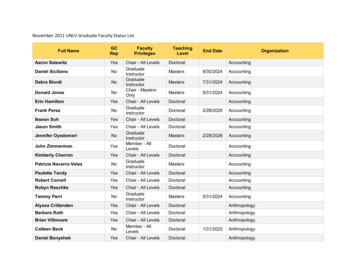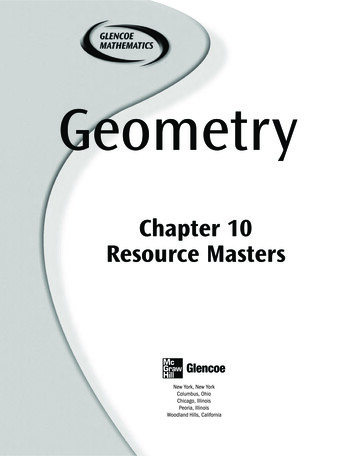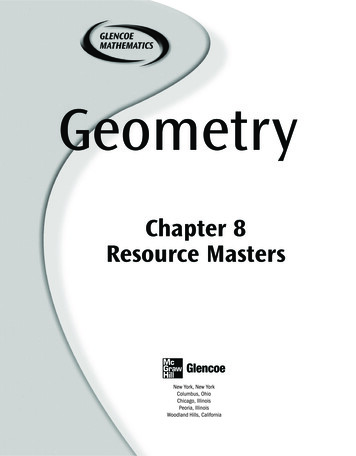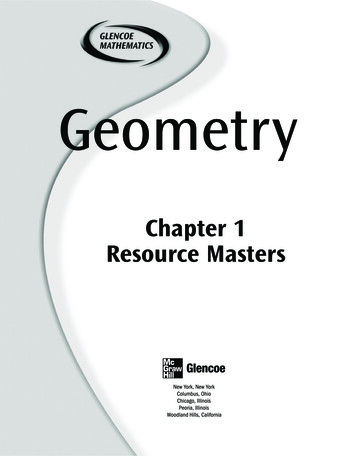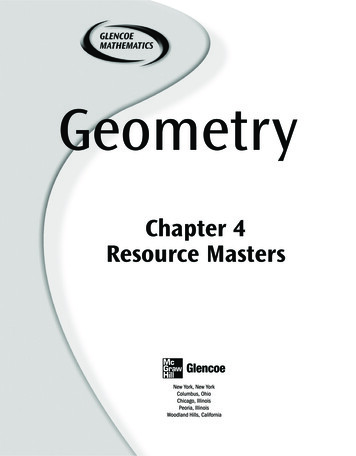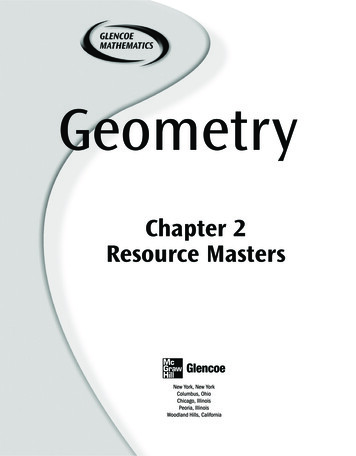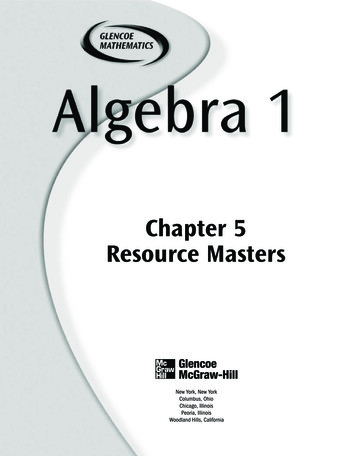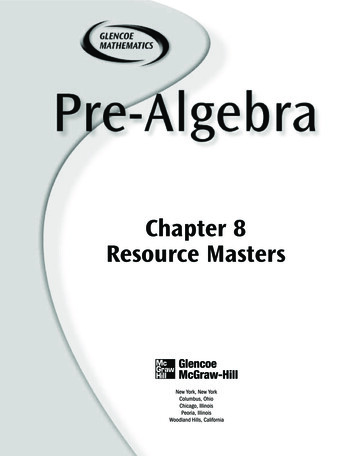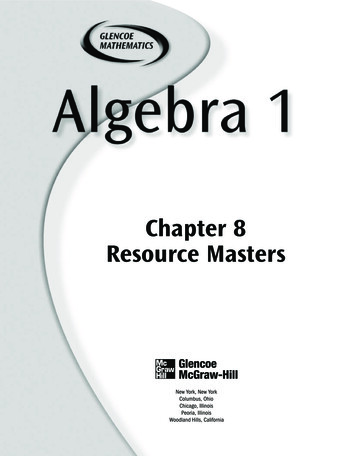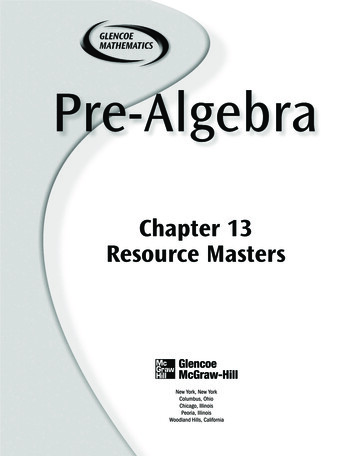
Transcription
Chapter 13Resource Masters
Consumable WorkbooksMany of the worksheets contained in the Chapter Resource Masters booklets areavailable as consumable workbooks in both English and Spanish.Study Guide and Intervention Workbook0-07-827794-9Study Guide and Intervention Workbook (Spanish)0-07-827795-7Skills Practice Workbook0-07-827788-4Skills Practice Workbook (Spanish)0-07-827790-6Practice Workbook0-07-827789-2Practice Workbook (Spanish)0-07-827791-4Answers for Workbooks The answers for Chapter 13 of these workbookscan be found in the back of this Chapter Resource Masters booklet.Spanish Assessment Masters Spanish versions of forms 2A and 2Cof the Chapter 13 Test are available in the Pre-Algebra Spanish AssessmentMasters (0-07-830412-1).Copyright by The McGraw-Hill Companies, Inc. All rights reserved.Printed in the United States of America. Permission is granted to reproduce thematerial contained herein on the condition that such material be reproduced onlyfor classroom use; be provided to students, teacher, and families without charge;and be used solely in conjunction with Glencoe Pre-Algebra. Any other reproduction, for use or sale, is prohibited without prior written permission of the publisher.Send all inquiries to:Glencoe/McGraw-Hill8787 Orion PlaceColumbus, OH 43240ISBN: 0-07-827779-51 2 3 4 5 6 7 8 9 10 047 11 10 09 08 07 06 05 04 03 02Pre-Algebra Chapter 13 Resource Masters
CONTENTSVocabulary Builder.viiLesson 13-6Lesson 13-1Study Guide and Intervention .758Skills Practice.759Practice .760Reading to Learn Mathematics .761Enrichment .762Study Guide and Intervention .733Skills Practice.734Practice .735Reading to Learn Mathematics .736Enrichment .737Lesson 13-2Study Guide and Intervention .738Skills Practice.739Practice .740Reading to Learn Mathematics .741Enrichment .742Lesson 13-3Study Guide and Intervention .743Skills Practice.744Practice .745Reading to Learn Mathematics .746Enrichment .747Chapter 13 AssessmentChapter 13 Test, Form 1 .763–764Chapter 13 Test, Form 2A .765–766Chapter 13 Test, Form 2B .767–768Chapter 13 Test, Form 2C.769–770Chapter 13 Test, Form 2D.771–772Chapter 13 Test, Form 3 .773–774Chapter 13 Open-Ended Assessment .775Chapter 13 Vocabulary Test/Review .776Chapter 13 Quizzes 1 & 2.777Chapter 13 Quizzes 3 & 4.778Chapter 13 Mid-Chapter Test.779Chapter 13 Cumulative Review .780Chapter 13 StandardizedTest Practice.781–782Lesson 13-4Study Guide and Intervention .748Skills Practice.749Practice .750Reading to Learn Mathematics .751Enrichment .752Standardized Test Practice StudentRecording Sheet .A1ANSWERS .A2–A32Lesson 13-5Study Guide and Intervention .753Skills Practice.754Practice .755Reading to Learn Mathematics .756Enrichment .757iii
Teacher’s Guide to Using theChapter 13 Resource MastersThe Fast File Chapter Resource system allows you to conveniently file the resources youuse most often. The Chapter 13 Resource Masters includes the core materials needed forChapter 13. These materials include worksheets, extensions, and assessment options. Theanswers for these pages appear at the back of this booklet.All of the materials found in this booklet are included for viewing and printing in thePre-Algebra TeacherWorks CD-ROM.Vocabulary BuilderPages vii-viiiinclude a student study tool that presentsup to twenty of the key vocabulary termsfrom the chapter. Students are to recorddefinitions and/or examples for each term.You may suggest that students highlightor star the terms with which they arenot familiar.When to Use Give these pages to studentsbefore beginning Lesson 13-1. Encourage themto add these pages to their Pre-Algebra StudyNotebook. Remind them to add definitions andexamples as they complete each lesson.Study Guide and InterventionEach lesson in Pre-Algebra addresses one ortwo objectives. There is one Study Guide andIntervention master for each lesson.When to Use Use these masters as reteaching activities for students who need additional reinforcement. These pages can alsobe used in conjunction with the StudentEdition as an instructional tool for studentswho have been absent.Skills Practice There is one master foreach lesson. These provide computationalpractice at a basic level.When to Use These masters can be usedwith students who have weaker mathematicsbackgrounds or need additional reinforcement.PracticeThere is one master for eachlesson. These problems more closely followthe structure of the Practice and Applysection of the Student Edition exercises.These exercises are of average difficulty.When to Use These provide additionalpractice options or may be used as homework for second day teaching of the lesson.Reading to Learn MathematicsOne master is included for each lesson. Thefirst section of each master asks questionsabout the opening paragraph of the lesson inthe Student Edition. Additional questionsask students to interpret the context of andrelationships among terms in the lesson.Finally, students are asked to summarizewhat they have learned using various representation techniques.When to Use This master can be used asa study tool when presenting the lesson oras an informal reading assessment afterpresenting the lesson. It is also a helpfultool for ELL (English Language Learner)students.EnrichmentThere is one extensionmaster for each lesson. These activitiesmay extend the concepts in the lesson, offeran historical or multicultural look at theconcepts, or widen students’ perspectiveson the mathematics they are learning.These are not written exclusively for honorsstudents, but are accessible for use with alllevels of students.When to Use These may be used as extracredit, short-term projects, or as activitiesfor days when class periods are shortened.iv
Assessment OptionsIntermediate Assessment Four free-response quizzes are includedto offer assessment at appropriate intervals in the chapter. A Mid-Chapter Test provides an optionto assess the first half of the chapter. It iscomposed of both multiple-choice andfree-response questions.The assessment masters in the Chapter 13Resource Masters offer a wide range ofassessment tools for intermediate and finalassessment. The following lists describe eachassessment master and its intended use.Chapter AssessmentContinuing AssessmentChapter Tests Form 1 contains multiple-choice questionsand is intended for use with basic levelstudents. Forms 2A and 2B contain multiple-choicequestions aimed at the average levelstudent. These tests are similar in formatto offer comparable testing situations. Forms 2C and 2D are composed of freeresponse questions aimed at the averagelevel student. These tests are similar informat to offer comparable testing situations. Grids with axes are provided forquestions assessing graphing skills. Form 3 is an advanced level test withfree-response questions. Grids withoutaxes are provided for questions assessinggraphing skills. The Cumulative Review providesstudents an opportunity to reinforce andretain skills as they proceed throughtheir study of Pre-Algebra. It can alsobe used as a test. This master includesfree-response questions. The Standardized Test Practice offerscontinuing review of pre-algebra conceptsin various formats, which may appear onthe standardized tests that they mayencounter. This practice includes multiplechoice, grid-in, and open-ended questions.Bubble-in and grid-in answer sections areprovided on the master.Answers Page A1 is an answer sheet for theStandardized Test Practice questionsthat appear in the Student Edition onpages 702–703. This improves students’familiarity with the answer formats theymay encounter in test taking. The answers for the lesson-by-lessonmasters are provided as reduced pageswith answers appearing in red. Full-size answer keys are provided for theassessment masters in this booklet.All of the above tests include a freeresponse Bonus question. The Open-Ended Assessment includesperformance assessment tasks that aresuitable for all students. A scoring rubric isincluded for evaluation guidelines. Sampleanswers are provided for assessment. A Vocabulary Test, suitable for all students, includes a list of the vocabularywords in the chapter and ten questionsassessing students’ knowledge of thoseterms. This can also be used in conjunction with one of the chapter tests or as areview worksheet.v
NAME DATE PERIOD13Reading to Learn MathematicsThis is an alphabetical list of key vocabulary terms you will learn in Chapter 13.As you study this chapter, complete each term’s definition or description.Remember to add the page number where you found the term. Add these pages toyour Pre-Algebra Study Notebook to review vocabulary at the end of the chapter.VocabularyTermFoundon ee-uhlcubic functionKYOO-bihkdegreeviiVocabulary BuilderVocabulary Builder
NAME DATE PERIOD13Reading to Learn MathematicsVocabulary BuilderVocabularyTermFoundon near functionpolynomialPAHL-uh-NOH-mee-uhlquadratic functionkwah-DRAT-ihktrinomialtry-NOH-mee-uhlviii
NAME DATEPERIOD13-1 Study Guide and InterventionPolynomialsPolynomials are classified according to the number of terms they have. A monomial has one term,a binomial has two terms, and a trinomial has three terms. The exponent of a variable in a monomialmust be a whole number, and the variable cannot be in the denominator or under a radical sign.Determine whether each expression is a polynomial. If it is, classifyit as a monomial, binomial, or trinomial.3y3a4a. 2y b. 6a3 5a4The expression is not aThe expression is a polynomial withthree terms, so it is a trinomial.3polynomial because hasya variable in the denominator.A polynomial also has a degree. The degree of a polynomial is the same as that of the term withthe greatest degree. The degree of a term is the sum of the exponents of its variables.Example 2Find the degree of each polynomial.a. x6 3x 4 1b. 10b2c 8bc c210b 2c has degree 2 1 or 3. 8bc hasdegree 1 1 or 2. c 2 has degree 2.The greatest degree is 6, so thedegree of the trinomial is 6.The greatest degree is 3, so thetrinomial has degree 3.ExercisesDetermine whether each expression is a polynomial. If it is, classify it as amonomial, binomial, or trinomial.1. 7q r 10yes; trinomial4. 89yes; monomial2. 8r 3. x 2 4noyes; binomial5. 3v2 4w6. a 5 b2 cyes; binomialyes; trinomialFind the degree of each polynomial.7. 28y 110. 9p3 6p2 3 Glencoe/McGraw-Hill8. 5h9. 2x 3y111. mn5 mn4 m2 6733412. 8x2 4xy y 2 2Glencoe Pre-AlgebraLesson 13-1Example 1
NAME DATEPERIOD13-1 Skills PracticePolynomialsDetermine whether each expression is a polynomial. If it is, classify it as amonomial, binomial, or trinomial.1. 5g82. x 2y zyes; monomial4. r2 9r5. d 1yes; binomialyes; monomial10. m 2 m yes; binomialnoyes; trinomialyes; trinomial14. 25 9h413. 24x3yes; monomialx21816. yes; trinomial19. 1yes; monomial12. a b cyes; trinomial15. u5 u 3 uyes; binomialx5yes; binomial9. a b2 311. 5y2 3y 1nono6. a3b2 a28. 17 c 7. n3x34yes; trinomial4x3. 5x 1 12yes; trinomial6a17. 1a1318. 2 yes; binomial20. 9y 5 no21. 27g5h2yes; binomialyes; monomialFind the degree of each polynomial.22. 14025. c3 c2 c 1328. k 4131. c6de3 c5 d1034. xy2 4x2y y2337. 8y2 8y 52 Glencoe/McGraw-Hill23. ab24. b2127. xy 3 z 126. mn565 5629. 30. 9.70032. a 2 2 a 3233. k3 3k4435. 7b5 1036. 16g 35138. abc 2ab 5c bc 1339. 4g2h5 2gh4 97734Glencoe Pre-Algebra
NAME DATEPERIOD13-1 PracticePolynomialsDetermine whether each expression is a polynomial. If it is, classify it as amonomial, binomial, or trinomial.2. v2 9vyes; monomial8b4. 6b 2 noyes; binomial5. m 10yes; monomial10. m n p11. y 4 5y 2yes; trinomial13. 5w7tyes; trinomial14. 41 qr4yes; monomial5x73716. 1217. yes; trinomialyes; binomial3c5cyes; monomial12. x x noyes; trinomial18. 10k 6 1220. 2 19. 4yes; trinomial15. p4 p 2 pyes; binomialv5yes; binomial9. h h2 18. qnoyes; trinomial6. a2b 2 9yes; binomial7. 1 s 2x273. g 2h jknoyes; binomial21. 7g2h7yes; monomialFind the degree of each polynomial.22. 5223. xy0225. 2c5 c3 c 9127. 2xy 4 z3 726. ab3548 4928. r 2529. 131. 12 9t 24. c30. 12.40t2234. xy2 3x2y xy337. cde8 c4 2e1032.5a30 a 8333. 1 c2 c4435. b 5 b 1.5536. 15k 2138. wxyz 2wx 5y yz 4 39. 6g2h8 gh5 341040. METEOROLOGY Summer simmer index measures the discomfort level due to temperatureand humidity. Meteorologists calculate this value by using a polynomial similar to1.98x2 115.93x 0.01xy 0.63y 6.33. The variable x is the temperature in Fand y is the relative humidity expressed as a whole number. What is the degree of thepolynomial? 2 Glencoe/McGraw-Hill735Glencoe Pre-AlgebraLesson 13-11. 3n2
NAME DATEPERIOD13-1 Reading to Learn MathematicsPolynomialsPre-ActivityHow are polynomials used to approximate real-world data?Do the activity at the top of page 669 in your textbook. Writeyour answers below.a. How many terms are in the expression for the heat index? 9b. What separates the terms of the expression?plus and minus signsReading the Lesson 1–4. See students’ work.Write a definition and give an example of each new vocabulary word.VocabularyDefinitionExample1. polynomial2. binomial3. trinomial4. degreeHelping You Remember5. Notice that the words binomial, trinomial, and polynomial contain the same root—nomial, but have different prefixes.a. Find the definition of the prefix bi- in a dictionary. Write the definition.Explain how it can help you remember the meaning of binomial.Two; a binomial contains two terms.b. Find the definition of the prefix tri- in a dictionary. Write the definition.Explain how it can help you remember the meaning of trinomial.Three; a trinomial contains three terms.c. Find the definition of the prefix poly- in a dictionary. Write the definition.Explain how it can help you remember the meaning of polynomial.Many; a polynomial contains many terms. Glencoe/McGraw-Hill736Glencoe Pre-Algebra
NAME DATEPERIOD13-1 EnrichmentA Cross-Number PuzzleUse the clues at the bottom of the page to complete the puzzle. Write one digitin each box.BCDGIJEHKLMNOTFLesson 13-1APQURVSWAcrossDownA x 2 4 for x 5A (6x 2 1) (4x 2 3) for x 5B 3xy 2 for x 4 and y 1B 7y 8y 2 for y 1C (2x 50) (x 15) for x 0D x x 2y 2 for x 7 and y 1E x 2 4x y 2 for x 10 and y 5F 5(7w 3w) for w 10G x 2 y for x 3 and y 7H (z 2 2z 1) (z 2 2z 2) for z 4I10w 5y for w 6 and y 1J 6xy 2 xy 60 for x 10 and y 10K 3x 2 5x 8 for x 10K w2 w 3 for w 6L ( y 8) (10 4y) for y 6L (3y 20) (45 3y) for y 16M 23x 16x for x 11M 11x 2 8x 2 for x 5O 7x 100y for x 5 and y 6N x 2 2x y 2 for x 10 and y 8Q (6x 2 2) (4x 2 3) for x 7P (2x 52) (x 11) for x 3T (x 2 x 7) (x 2 2) for x 3R 2x 2 5x 140 for x 12U x 2 y for x 2 and y 8S ( y 75) (120 4y) for y 6V 7y 12y 2 for y 10W w 2 w 7 for w 9 Glencoe/McGraw-Hill737Glencoe Pre-Algebra
NAME DATEPERIOD13-2 Study Guide and InterventionAdding PolynomialsAdd polynomials by combining like terms, which are monomials that contain the same variablesto the same power.ExampleFind (8x2 7x 1) (x2 5).Method 1 Add vertically.8x2 7x 1( ) x2 529x 7x 6Method 2 Add horizontally.(8x2 7x 1) (x2 5) (8x2 x2) 7x (1 5) 9x2 7x 6ExercisesFind each sum.1.3x 7( ) x 12.4x 63.4w2 6w 3( ) w2 56d 8( ) 4d 12d 94.5a2 a( )2a 55w 2 6w 25a 2 a 55. ( m 3) (7m 1)6. (9x2 3x 1) (4x 1)6m 27. (2k2 k) (k 1)2k 2 19. (4c2 7) (c2 3c 6)5c 2 3c 111. (12h 6) (h2 8h 6)h 2 4h13. (6y2 y 1) (y2 3y 6)7y 2 4y 515. (3g2 3g 5) (5g2 3)8g 2 3g 2 Glencoe/McGraw-Hill9x 2 7x8. (5a2 6ab) ( ab b2)5a 2 5ab b 210. (x2 y) (xy y)x 2 xy 2y12. (10x2 x 5) (x 10x2)2x 514. ( p3 4) (2p2 2p 3)p 3 2p 2 2p 716. (5r2 6) ( r 2 4r 7)4r 2 – 4r 1738Glencoe Pre-Algebra
NAME DATEPERIOD13-2 Skills PracticeAdding PolynomialsFind each sum.5q 7( ) 2q 22.r2 3r( ) r2 4r 14.w2 – 3w 3( ) w2 4w 16.–p2 6p 8( ) p2 4p 58. 3v2 v( ) 2v 77q 53.5f 72r 2 r 15.2p 39.6m2 m 1( )2m2 2m 38m 2 m 29n2 3n( )3n 59n 2 52w 2 w 47.7f 10( ) 2f 38c2 4c 6( ) c2 c 19c 2 3c 53v 2 v 710.5d2 7d 4( ) 5d2 6d 410d 2 d 811. (2r2 3) ( r2 4r 1)12. ( g 2 2g 5) (5g2 2g 3)13. ( m 9) (3m 3)14. (2x2 8x 7) (3x 5)15. (k2 k) (7k2 k 2)16. (4a2 3ab) (ab 2b2)r 2 4r 22m 128k 2 2k 26g 2 82x 2 11x 24a 2 4ab 2b 217. (5c 7) (3c2 4c 6)18. (x2 xy) (xy y2)19. ( h2 3h 6) (4h2 2h 3)20. (x2 x 1) (2x 9x2)21. (6g2 2g 3) (2g2 5g)22. (b2 b 1) (b2 b 1)3c 2 c 13h 2 h 38g 2 3g 323. (2y2 7y 9) (y2 4y 6)3y 2 11y 3Glencoe/McGraw-Hillx 2 2xy y 2 8x 2 3x 12b 224. (7p3 4) (2p2 5p 1)7p 3 2p 2 5p 3739Glencoe Pre-AlgebraLesson 13-21.
NAME DATEPERIOD13-2 PracticeAdding PolynomialsFind each sum.1.8q 3( ) 4q 22.4r2 11r( ) 5r2 3r 74.6w2 2w 7( )8w2 3w 96. 5p2 2p 4( ) 5p2 2p 48.12q 13.8f 189r 2 8r 75.9f 3( ) f 15n2 3n( )3n 10n 2 108c2 3c 15( ) 3c2 3c 1114w 2 5w 27.11c 2 414v 2 3v 509.5m2 6m 3( )8m2 9m 27v2 2v( ) 7v2 v 510.13m 2 15m 511. (r2 9) ( 4r2 6r 10)7d 2 8d – 3( ) d 2 d 38d 2 9d12. (g 2 3g – 6) (6g2 6g 1) 3r 2 6r 197g 2 3g 513. ( 2m 10) (5m 3)14. (4x2 7x) (8x 5)3m 715. (3k2 9k) (k2 2k 4)4x 2 x 516. (2a2 3ab) (4ab 8b2)4k 2 7k 417. (c 4) (c2 c 6)2a 2 ab 8b 218. (5x2 3xy) (2xy 9y2)c 2 1019. (2y3 y2 5) (2y2 3y)5x 2 xy 9y 220. ( 5p2 6p 7) (p2 2)2y 3 3y 2 3y 521. (3ab2 2a 1) (a2 ab 3) 4p 2 6p 922. (6rs3 4r) (5rs3 7)3ab 2 a 2 2a ab 211rs 3 4r 723. GEOMETRY The lengths of the sides of a triangle are (x2 5), (7x 1), and x.Find the perimeter of the triangle. x 2 8x 6 Glencoe/McGraw-Hill740Glencoe Pre-Algebra
NAME DATEPERIOD13-2 Reading to Learn MathematicsAdding PolynomialsPre-ActivityHow can you use algebra tiles to add polynomials?Do the activity at the top of page 674 in your textbook. Writeyour answers below.a. Write the polynomial for the tiles that remain. x 2 2x 2b. Find the sum of x2 4x 2 and 7x2 2x 3 by using algebra tiles.8x 2 2x 5c. Compare and contrast finding the sums of polynomials with findingthe sum of integers. The concept of the zero pairs is thesame, but there are tiles that represent different terms inpolynomials.1. Draw a model that shows (x2 4x 2) (2x2 2x 3). Write the polynomial thatshows the sum. 3x 2 2x 12. Show how to find the sum (5x – 2) (4x 4) both vertically and horizontally.Vertically5x 2( )4x 49x 2Horizontally(5x 2) (4x 4) (5x 4x) ( 2 4) 9x 2Helping You Remember3. You have learned that you can combine like terms. On the left below, write three pairs ofmonomials that have like terms. On the right below, write three pairs of monomials thathave unlike terms. Explain your answers. Sample answers are given.Like Terms Unlike Terms1. 23a and 12a1. 2xy and 2x2. 4b 2c and b 2c2. 3mn 2 and 3m 2n3. xy 3 and 2xy 33. 8ab 3 and 5ab 2Glencoe/McGraw-Hill741Glencoe Pre-AlgebraLesson 13-2Reading the Lesson
NAME DATEPERIOD13-2 EnrichmentAdding PolynomialsCan you make a sentence using these words?A FRUITTIMELIKEANBUTFLIESBANANAARROWLIKEFLIESAdd the polynomials. Then find the word in the table at the right that corresponds to thesum. Read the words in order down the column to discover the hidden saying.Word1. (2x2 3x2) (5x2 x2) 11x 2TIME2. (2x2 3x3) (5x2 x2) 3x 3 8x 23. (2x2 x) (xy x) 2x 2 2x xy4.(x3 2x2) (5x3 x) 6x 3 2x 2 x5. (x xy) (x2 xy) x 2 2xy x6.(5x2 x) (x 2x4)2x 4 5x 2 2x7. (xy y2 x2) (2xy x2)FLIESLIKEANARROW9. (x x2) x3 x 3 x 2 xFRUIT Glencoe/McGraw-Hill2x2 3xy y2FRUIT11x2TIMEx3 x2 xLIKE6x3 2x2 xAN2x4 5x2 2xBUT3x3 8x2FLIES4x12BANANAx2 2xy xARROW2x2 2x xyLIKE3x3 3x2 xFLIESFLIESLIKE10. (x3 x3) (x3 x3) 4x 311. 2x12 2x12 4x 12ABUT2x 2 3xy y 28. (3x2 2x3) (x3 x) 3x 3 3x 2 x4x3ABANANA742Glencoe Pre-Algebra
NAME DATEPERIOD13-3 Study Guide and InterventionSubtracting PolynomialsTo subtract polynomials, subtract like terms.ExampleFind (x2 3x 6) (4x2 1).Method 1 Subtract vertically.Method 2 Add the additive2x 3x 6inverse of 4x 2 1, which is2( ) 4x 1( 1)(4x 2 1) or 4x2 1. 3x2 3x 5 (x 2 3x 6) (4x2 1) (x 2 3x 6) ( 4x2 1) (x 2 4x 2 ) (3x) ( 6 1) 3x2 3x 5ExercisesFind each difference.4c 7( ) 3c 32.c 43.( )9k2 4k 5k2 510m 44.8k 2 4k 105. (–6r 3) – (7r 2)6. (8f 2 – 7f – 3) – (2f 4)8f 2 9f 78. (a2 5ab) – (–2ab – 3b2)5n 2 5n 99. (6g2 8) – (5g2 – 2g 6)a 2 7ab 3b 210. (8x2 – 3y) – (2xy 3y)g 2 2g 211. (n – 12) – (n2 n 9)8x 2 2xy 6y12. (h2 – 2h 1) – (3h – 7h2) n 2 2113. (y 2 y 1) – (y 2 – y 1)8h 2 5h 114. (6p2 – 5p – 1) – (2p – 4)6p 2 7p 32y15. (4q2 q) – (q2 3)16. (6v2 8) – (7v2 2v – 5)3q 2 q 317. (u 2 u – 4) – (5u2 – 4) v 2 2v 1318. (9b 2 2) – (–b 2 b 9) 4u 2 u Glencoe/McGraw-Hill3z2 z( )3z 53z 2 4z 5 13r 17. (5n2 – 2n) – (3n 9)2m 5( ) 8m 1Lesson 13-31.10b 2 b 7743Glencoe Pre-Algebra
NAME DATEPERIOD13-3 Skills PracticeSubtracting PolynomialsFind each difference.1.7y 5( ) y 62.6y 13.w2 w 1( ) 2w2 3w 2–k 174. w 2 2w 15.3d2 d( ) d2 3d 82m2 5m 3( ) 5m2 m 36.– q2 2q 2( ) q2 7q 98.10.12. (7k2 k 8) (2k2 3k 3)5k 2 4k 1114. (4x2 11x 7) (x2 3x 6)a2 a 515. (k2 3k) (2k2 7k 1)3x 2 14x 116. (5a2 ab) (ab 3b2) k 2 4k 117. (5u2 7) (3u2 4u 6)5a 2 3b 218. (4m2 mn) (3mn n2)2u 2 4u 1319. (h2 3h 6) (h2 2h 3)4m 2 2mn n 220. (x2 x 1) (2x 9x2)5h 321. (6g2 3g 3) (g2 g 5) 8x 2 3x 122. (b2 b 1) (b2 b 1)5g 2 2g 823. (a2 9a 10) (a2 a 4)2b 224. (4r 2 7r) (3r2 2r 7) 8a 6 Glencoe/McGraw-Hillv2 v( ) 8v2 8v 8 7v 2 9v 82r 2 9r 413. (a2 9) (a 4)d2 3d 6( ) d2 2d 1 d 5 2q 2 9q 711. (r2 10r 3) ( r2 r 1)7n2 3n( ) n2 3n 18n 2 1 3m 2 4m 69.c2 7c 2( ) c2 c 12c 2 6c 32d 2 2d 87.k 8( ) 2k 9r 2 9r 7744Glencoe Pre-Algebra
NAME DATEPERIOD13-3 PracticeSubtracting PolynomialsFind each difference.4y 1( ) 3y 82.y 73.5j 2 2 j 2( ) j 2 9 j 2 5k 94.4j 2 7j 45.d2 4d 6( ) d2 3d 89m2 4m 13( ) 7m2 2m 3c2 5c 3( ) c2 5c 12c 2 10c 26. 7d 147.2k 3( ) 7k 62n2 3n 10( ) n2 3n 83n 2 188.d2 3d 6( ) d2 3d 62m 2 2m 169. 6q2 3q 2( ) 3q2 4q 4 1210. 9q 2 7q 211. (4n2 n 6) ( 2n2 3n 14) v 2 8v 312. (3k2 9k) (8k2 12)6n 2 2n 813. (k2 7) (k 11) 5k 2 9k 1214. (9x2 x 2) – (3x2 x 4)k2 k 415. (k2 12) (k2 6k 9)6x 2 216. (k2 4kb) (5kb 2b2) 6k 317. (3u2 9) (u2 21u 2)k 2 kb 2b 218. (5m2 4mn) (4mn 8n2)2u 2 21u 1119. (h2 8h 5) (h2 3h 7)5m 2 8mn 8n 220. (2x2 4x 8) (2x 8x2)11h 1221. (6g2 3g 2) (g2 g 4)v2 v( ) 2v2 9v 310x 2 6x 822. (b3 b2 ab) (b3 3b2 5)5g 2 2g 6 2b 2 ab 523. POOLS A swimming pool is (4w2 16) feet long and (w 16) feet wide. How muchlonger is the length than the width? 4w 2 w ft Glencoe/McGraw-Hill745Glencoe Pre-AlgebraLesson 13-31.
NAME DATEPERIOD13-3 Reading to Learn MathematicsSubtracting PolynomialsHow is subtracting polynomials similar to subtractingmeasurements?Pre-ActivityDo the activity at the top of page 678 in your textbook. Writeyour answers below.a. What is the difference in degrees and the difference in minutesbetween the two stations? 4 degrees, 8.1 minutesb. Explain how you can find the difference in latitude between any twolocations, given the degrees and minutes. Subtract the degreesand subtract the minutes.c. The longitude of Station 1 is 162 16 36 and the longitude ofStation 5 is 68 8 2 . Find the difference in longitude between thetwo stations. 94 8 34 Reading the Lesson1. Show how to find the difference (3x2 x 2) – (2x2 – 7) by aligning like terms and byadding the additive inverse.Like TermsAdditive Inverse3x 2 x 2( ) 2x 23x 2 x 2 7( ) 2x 2x2 x 9 7x2 x 92. Which method do you prefer? Why? Answers will vary.Helping You Remember3. a. You have learned to subtract polynomials by adding the additive inverse. Look upinverse in the dictionary. What is its definition? How does this help you rememberhow to find the additive inverse? Opposite; you change each sign to theopposite and then add instead of subtract.b. Write the additive inverses of the polynomials in the table below. PolynomialAdditive Inversex2 2x 3 x 2 2x 36x 8 6x 85x2 8y 2 2xy 5x 2 8y 2 2xyGlencoe/McGraw-Hill746Glencoe Pre-Algebra
NAME DATEPERIOD13-3 EnrichmentPolynomials with Fractional CoefficientsPolynomials may have fractional coefficients in some or all of the terms. Computation withthese types of polynomials is done in the same way as with whole-number coefficients.Add or subtract. Write all coefficients as fractions.34251611124314151. Add x 2 y 2 and x 2 y 2. x 2 y 21213141312165613127122. From x 2 xy 2 y 2, take x 2 xy y 2. x 2 xy 2 xy y 2324378671814325 x y821143. Add x y, x y, and y x.162358121212344. Subtract x 2 x from x 2 x . x 2 x 1311121518497916341331058121912Lesson 13-35. Add xy y 2 to xy y 2. xy y 229 x 2 x . x 2 x 6. Add x 2 x and 12233471214181638561219127. From y y 2, take y y 2. y y 23411216138. Subtract x from x . x 3813591212137856299. Add x 2 xy y 2 and x 2 xy y 2. x 2 xy y 2341243787123810. Subtract y 2 y from y 2 y. y 2 y Glencoe/McGraw-Hill747Glencoe Pre-Algebra
NAME DATEPERIOD13-4 Study Guide and InterventionMultiplying a Polynomial by a MonomialThe Distributive Property can be used to multiply a polynomial by a monomial.Example 1Find 7(4x 8).7(4x 8) 7(4x) 7(8) 28x 56Example 2Find (x 2 5x 4)( 2x).(x 2 5x 4)( 2x) x 2 ( 2x) 5x( 2x) 4( 2x) 2x 3 10x 2 8xExercisesFind each product.1. 5(7y 4)2. (3h 6)435y 2012h 244. 6(d – 2) 6n 18 b 3 4b8. (a2 – 2ab b2)55a 2 10ab 14. p(7p – 2) 6m 27p 2 m 2a 2b 3w 20. 2y(5y 1) 10y 2 mn22. (5r2 – 2r)(–3r) 15r 3 6r 225. 4p2(6p2 3p)24p 4 12p 328. 3m(2m 4n) 12mnGlencoe/McGraw-Hill2k 3 9k 23h 2 8h18. x(7x y)7x 2 xyab 219. (m2 – mn – n)m 12. (2k – 9)(k2) 2p17. ab(2a b)2w 2r 2 9r15. (8 – 3h)(–h)16. w(4w2 – 2w 3)6m 29. r(r 9)5b 2 3x 2 6x13. –m(6m 1)m 2n 28x 2 4911. –x(3x 6)
Practice There is one master for each lesson. These problems more closely follow . The answers for the lesson-by-lesson . 4. r2 39r 5. d 1 6. a b2 a2 yes; binomial yes; binomial yes; binomial 7. n 8. 17 c 9. a b2 3 yes; monomial no yes; trinomial 10. m 2 m 11. 5y2 3y 1 12. a b c


